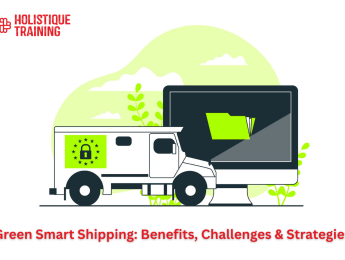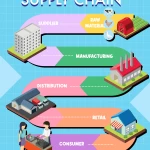- Table of Contents
- Introduction
- What is Green Smart Shipping?
- Energy Transition in Shipping
- Alternative Fuels
- Energy Efficiency Technologies
- Benefits of Green Smart Shipping in Sustainable Logistics
- Economic Benefits
- Social Benefits
- Environmental Benefits
- How to Make Your Shipping Sustainable
- 1. Optimize Logistics
- 2. Invest in Energy-Efficient Technologies
- 3. Choose Sustainable Partners
- 4. Educate and Train Employees
- 5. Monitor and Report Emissions
- 6. Engage in Carbon Offsetting and Insetting
- 7. Implement Circular Economy Principles
- What is Carbon Offsetting and Insetting?
- Carbon Offsetting
- Carbon Insetting
- Challenges of Green Smart Shipping
- 1. High Initial Costs
- 2. Regulatory Uncertainty
- 3. Technological Limitations
- 4. Market Acceptance
- 5. Knowledge Gaps
- Conclusion
Introduction
The shipping industry plays a pivotal role in global trade and commerce, transporting over 80% of the world’s goods by volume. However, this essential sector faces increasing scrutiny due to its environmental impact, particularly concerning greenhouse gas emissions and pollution. As the world shifts towards a more sustainable future, the concept of "Green Smart Shipping" has emerged as a beacon of hope. This blog post delves into what green smart shipping entails, the energy transition within the shipping industry, its benefits for sustainable logistics, practical steps for making shipping more sustainable, the concepts of carbon offsetting and insetting, the challenges faced, and finally, a look at the future of this vital industry.
What is Green Smart Shipping?
Green smart shipping refers to the integration of environmentally friendly practices and smart technologies in the shipping industry. It encompasses a range of strategies aimed at reducing the ecological footprint of maritime operations. At its core, green smart shipping combines sustainable practices with innovative technologies to optimize efficiency and minimize environmental impact.
This approach includes the use of alternative fuels, such as LNG (liquefied natural gas), hydrogen, and biofuels, alongside advancements in digital technologies like AI, IoT (Internet of Things), and big data analytics. By leveraging these technologies, shipping companies can enhance operational efficiency, reduce fuel consumption, and ultimately lower emissions.
The goal of green smart shipping is not only to comply with international regulations, such as the IMO 2020 sulfur cap, but also to proactively contribute to global sustainability goals, including the Paris Agreement. As stakeholders across the industry recognize the importance of adopting green practices, the transition towards green smart shipping becomes increasingly essential.
Energy Transition in Shipping
The energy transition in shipping is a critical component of green smart shipping. Traditionally reliant on heavy fuel oil, the shipping industry is now exploring various alternative energy sources to reduce its carbon footprint. This transition involves a multi-faceted approach that includes the development of new technologies, the adoption of cleaner fuels, and the implementation of energy-efficient practices.
Alternative Fuels
One of the most significant shifts is the exploration of alternative fuels. Liquefied natural gas (LNG) has gained traction as a cleaner alternative to traditional fuels, producing lower emissions of sulfur oxides (SOx) and nitrogen oxides (NOx). However, LNG is still a fossil fuel, leading many to advocate for even greener options such as hydrogen and ammonia. These fuels, when produced from renewable sources, offer the potential for zero-emission shipping.
Biofuels, derived from organic materials, are also being explored as a viable option. They can be blended with traditional fuels to reduce emissions without requiring significant modifications to existing engines.
Energy Efficiency Technologies
In addition to alternative fuels, energy efficiency technologies play a crucial role in the energy transition. Innovations such as wind-assisted propulsion, energy-saving devices, and hull modifications can significantly enhance a vessel's efficiency. For instance, the use of sails or kites can harness wind energy, reducing the reliance on engines and lowering fuel consumption.
Moreover, digital technologies are revolutionizing ship operations. Advanced analytics and AI can optimize routing, speed, and cargo loading, further enhancing fuel efficiency. By employing real-time data and predictive analytics, shipping companies can make informed decisions that lead to reduced emissions and operational costs.
Benefits of Green Smart Shipping in Sustainable Logistics
Adopting green smart shipping practices brings a multitude of benefits that extend beyond mere compliance with environmental regulations. These advantages can be categorized into economic, social, and environmental dimensions, each contributing to a more sustainable logistics framework.
Economic Benefits
Cost Savings:
Implementing energy-efficient technologies and alternative fuels can lead to significant long-term cost savings. While the initial investment in green technologies may be substantial, the reduction in fuel consumption often results in lower operational costs over time. For example, ships equipped with energy-saving devices can experience reductions in fuel usage of up to 10-15%, translating to considerable savings, especially in an industry where fuel costs represent a significant portion of total expenses.
Market Competitiveness:
As consumers increasingly prioritize sustainability, companies that adopt green practices can enhance their competitive edge. A commitment to environmentally friendly shipping can attract environmentally conscious customers and partners, leading to increased market share. Companies that effectively communicate their sustainability efforts often find themselves favored in tender processes, gaining contracts that may have otherwise gone to competitors with less focus on green initiatives.
Regulatory Compliance:
With the introduction of stricter environmental regulations, adopting green smart shipping practices ensures compliance with international standards, such as the IMO 2020 sulfur cap. By proactively implementing sustainable practices, companies can avoid penalties and fines associated with non-compliance, fostering smoother operations and enhancing their reputation in the industry.
Access to Funding and Incentives:
Many governments and organizations offer financial incentives for companies that invest in sustainable practices. This can include grants, tax breaks, or low-interest loans aimed at supporting the transition to greener technologies. By aligning with sustainability goals, companies can leverage these opportunities to offset the costs of implementing green solutions.
Social Benefits
Public Health:
The reduction of emissions and pollutants from shipping activities contributes significantly to improved air quality, particularly in port cities and coastal regions. Cleaner air leads to better public health outcomes, reducing the incidence of respiratory diseases and other health issues associated with air pollution. This positive impact on community health can enhance the social license to operate for shipping companies, fostering goodwill among local populations.
Job Creation:
The shift towards green technologies and sustainable practices can create new job opportunities across various sectors. As the demand for skilled workers in renewable energy, sustainable logistics, and green technologies grows, the shipping industry can contribute to job creation. This transition requires a workforce that is trained in new technologies and practices, encouraging the development of educational programs and training initiatives that prepare individuals for careers in the green economy.
Community Engagement:
Companies that prioritize sustainability often engage more actively with local communities, fostering partnerships and collaborative initiatives. This engagement can lead to community development projects, educational programs, and environmental stewardship efforts that benefit both the company and the community. By actively participating in local sustainability initiatives, shipping companies can strengthen their relationships with stakeholders and enhance their corporate social responsibility profiles.
Environmental Benefits
Reduced Emissions:
The most significant advantage of green smart shipping is the substantial reduction in greenhouse gas emissions. By transitioning to cleaner fuels and enhancing energy efficiency, the shipping industry can significantly lower its carbon footprint. For instance, the adoption of LNG can reduce CO2 emissions by approximately 20-30% compared to traditional fuels, while biofuels can offer even greater reductions when sourced sustainably. In line with these efforts, the International Maritime Organization (IMO) has established bold goals, aiming for a minimum 50% reduction in greenhouse gas emissions by 2050, relative to 2008 levels, according to Clarksons.
Biodiversity Protection:
Sustainable shipping practices help protect marine ecosystems by minimizing pollution and reducing the risk of oil spills and other environmental disasters. By adopting measures such as ballast water management and reducing emissions, shipping companies can mitigate their impact on marine biodiversity. This protection is vital for maintaining healthy oceans, which are crucial for global climate regulation and the livelihoods of millions who depend on marine resources.
Resource Efficiency:
Green smart shipping promotes the efficient use of resources, reducing waste and encouraging recycling and reuse. By optimizing logistics and supply chain management, companies can minimize excess packaging, reduce fuel consumption, and enhance overall resource efficiency. This not only benefits the environment but also contributes to a circular economy, where resources are kept in use for as long as possible.
Climate Resilience:
By adopting sustainable practices, the shipping industry can enhance its resilience to climate change impacts. As extreme weather events become more frequent, companies that invest in green technologies and practices are better positioned to adapt to changing conditions. This resilience not only protects assets and operations but also ensures the continuity of supply chains in the face of climate-related disruptions.
In summary, the benefits of green smart shipping in sustainable logistics are multifaceted, encompassing economic, social, and environmental dimensions. As the shipping industry embraces these practices, it not only contributes to a more sustainable future but also positions itself as a leader in the global movement towards environmental responsibility. The transition towards green smart shipping is not just a trend; it is an imperative for the industry and the planet.
How to Make Your Shipping Sustainable
Transitioning to sustainable shipping practices is essential for businesses that want to minimize their environmental impact while enhancing operational efficiency. Here are several effective strategies to make shipping more sustainable:
1. Optimize Logistics
Streamlining logistics involves analyzing and refining the entire supply chain to reduce emissions and improve efficiency. Key strategies include:
- Route Optimization: Utilize advanced software and algorithms to determine the most efficient shipping routes. This can minimize travel distance and time, reducing fuel consumption and emissions. Real-time data can also help adjust routes based on traffic conditions, weather, and other factors.
- Consolidation of Shipments: Combining multiple shipments into a single load can significantly reduce the number of trips required. This not only lowers fuel consumption but also reduces packaging waste. Implementing a just-in-time inventory system can help align shipments with demand, further optimizing logistics.
- Multi-Modal Transportation: Consider using a combination of transportation modes (e.g., rail, road, sea) to optimize the shipping process. Each mode has different emissions profiles, and selecting the most efficient combination can lead to substantial reductions in the overall carbon footprint.
2. Invest in Energy-Efficient Technologies
Investing in energy-efficient technologies is crucial for reducing fuel consumption and emissions. Strategies include:
- Retrofitting Existing Vessels: Many older ships can be retrofitted with energy-saving devices, such as bulbous bows, energy-saving propellers, and hull modifications that improve hydrodynamics. These enhancements can lead to significant fuel savings.
- New Vessel Design: When purchasing new vessels, consider designs that prioritize energy efficiency. Look for features such as optimized hull shapes, lightweight materials, and advanced propulsion systems that reduce fuel consumption.
- Renewable Energy Sources: Explore the integration of renewable energy technologies, such as solar panels or wind-assisted propulsion systems. These technologies can supplement traditional power sources, further reducing reliance on fossil fuels.
3. Choose Sustainable Partners
Selecting sustainable partners throughout the supply chain is vital for amplifying the impact of green initiatives:
- Supplier Evaluation: Assess suppliers based on their sustainability practices. Partnering with suppliers who prioritize eco-friendly materials and processes can enhance your overall sustainability profile.
- Sustainable Freight Carriers: Choose freight carriers that have demonstrated a commitment to green practices, such as using alternative fuels or implementing energy-efficient technologies. Collaborating with these carriers can help ensure that your shipping practices align with your sustainability goals.
- Collaboration and Sharing Best Practices: Engage with industry peers to share knowledge and best practices regarding sustainability. Collaborative efforts can lead to innovative solutions and shared resources, amplifying the impact of sustainability initiatives.
4. Educate and Train Employees
Employee training is vital for effectively implementing sustainable practices:
- Awareness Programs: Conduct training sessions to raise awareness about the importance of sustainability in shipping. Educate employees on how their roles contribute to the company’s sustainability goals.
- Skill Development: Provide training on specific green technologies and practices, ensuring that employees are equipped to implement and maintain these initiatives effectively. This can include training on energy-efficient operations, waste reduction strategies, and sustainable sourcing.
- Encouraging Employee Involvement: Foster a culture of sustainability by encouraging employees to propose ideas for improving practices. Establishing sustainability committees or initiatives can empower employees to take ownership of green initiatives.
5. Monitor and Report Emissions
Regularly monitoring and reporting emissions is essential for tracking progress and identifying areas for improvement:
- Establish Clear Metrics: Define key performance indicators (KPIs) related to emissions and sustainability goals. This can include metrics such as fuel consumption per mile, total emissions, and waste generation.
- Implement Tracking Systems: Utilize technology to monitor emissions in real-time. This can involve using sensors, IoT devices, and software platforms that provide data on fuel consumption, engine performance, and other relevant metrics.
- Transparency and Reporting: Regularly report emissions data and sustainability progress to stakeholders, including customers, investors, and regulatory bodies. Transparency fosters accountability and can enhance the company’s reputation as a responsible business.
6. Engage in Carbon Offsetting and Insetting
Incorporating carbon offsetting and insetting strategies can further enhance sustainability efforts:
- Carbon Offsetting: Invest in projects that compensate for emissions produced through shipping activities. This can include reforestation initiatives, renewable energy projects, or community-based sustainability programs. Purchasing carbon credits allows companies to offset their emissions while contributing to global sustainability efforts.
- Carbon Insetting: Focus on reducing emissions within the supply chain. This may involve supporting sustainable practices among suppliers or investing in renewable energy for shipping operations. By taking responsibility for emissions throughout the value chain, companies can significantly reduce their overall carbon footprint.
7. Implement Circular Economy Principles
Adopting circular economy principles can further enhance sustainability:
- Reduce, Reuse, Recycle: Focus on minimizing waste by reducing packaging, reusing materials, and recycling wherever possible. This can include using biodegradable packaging materials or establishing take-back programs for products at the end of their life cycle.
- Lifecycle Assessments: Conduct lifecycle assessments of products to identify opportunities for reducing environmental impact throughout the entire supply chain, from production to disposal. Understanding the full impact of products can inform more sustainable decision-making.
- Collaboration for Circular Solutions: Work with industry partners to develop circular solutions that promote resource efficiency and reduce waste. Collaborative initiatives can lead to innovative approaches that benefit all parties involved.
Making shipping sustainable requires a comprehensive approach that encompasses logistics optimization, technology investment, employee engagement, and collaboration with partners. By implementing these strategies, businesses can significantly reduce their environmental impact while enhancing operational efficiency and contributing to a more sustainable future. As the shipping industry continues to evolve, the commitment to sustainability will not only benefit the planet but also position companies as leaders in the global movement towards responsible and eco-friendly practices.
What is Carbon Offsetting and Insetting?
As part of the transition towards greener practices, the concepts of carbon offsetting and insetting have gained prominence.
Carbon Offsetting
Carbon offsetting involves compensating for emissions produced by investing in projects that reduce or remove an equivalent amount of carbon dioxide from the atmosphere. This can include reforestation projects, renewable energy initiatives, and energy efficiency programs. By purchasing carbon credits, companies can offset their emissions and work towards achieving carbon neutrality.
Carbon Insetting
In contrast, carbon insetting focuses on reducing emissions within a company's own supply chain. This approach involves implementing sustainable practices that directly reduce a company's carbon footprint. For example, a shipping company might invest in renewable energy for its operations or support sustainable practices among its suppliers. Insetting emphasizes the need for companies to take responsibility for their emissions and actively work to reduce them throughout their value chain.
Aspect | Carbon Offsetting | Carbon Insetting |
Definition | Compensating for emissions by investing in external projects that reduce or remove an equivalent amount of CO2. | Reducing emissions within a company's own supply chain through sustainable practices. |
Focus | External projects (e.g., reforestation, renewable energy initiatives). | Internal operations and supply chain improvements. |
Implementation | Typically involves purchasing carbon credits from third-party projects. | Involves direct investments in sustainable practices and technologies within the company. |
Measurement | Emissions are offset by the amount of CO2 reduced or removed by the external project. | Emissions reductions are measured based on improvements made within the company's operations. |
Goal | Achieve carbon neutrality by balancing emissions with offsets. | Actively reduce a company's carbon footprint and promote sustainability throughout the supply chain. |
Both offsetting and insetting are essential tools in the journey towards sustainability, allowing companies to address their carbon footprint while contributing to global efforts to combat climate change.
Challenges of Green Smart Shipping
Despite the numerous benefits, the transition to green smart shipping is not without its challenges. Some of the key obstacles include:
1. High Initial Costs
Investing in green technologies and alternative fuels often requires significant upfront capital. Many shipping companies, particularly smaller operators, may struggle to finance these investments, hindering their ability to adopt sustainable practices.
2. Regulatory Uncertainty
The shipping industry operates in a complex regulatory environment, with varying standards across different regions. This uncertainty can complicate planning and investment decisions, as companies may be unsure about future regulations and compliance requirements.
3. Technological Limitations
While advancements in technology are promising, many green technologies are still in the early stages of development. There may be limitations in terms of availability, scalability, and reliability, which can impede widespread adoption.
4. Market Acceptance
Shifting to alternative fuels and sustainable practices requires buy-in from various stakeholders, including customers, suppliers, and regulators. Achieving consensus on the best approaches and practices can be challenging, particularly in a global industry with diverse interests.
5. Knowledge Gaps
Many companies lack the necessary expertise and knowledge to implement green smart shipping practices effectively. Training and educating employees, as well as fostering collaboration among industry players, is crucial for overcoming this barrier.
Here’s a table that highlights the key challenges faced in smart green shipping and presents actionable solutions to help overcome these obstacles, fostering a more sustainable maritime industry:
Challenge | Solution |
High Initial Costs | Seek government grants and subsidies for green technologies; explore financing options. |
Regulatory Uncertainty | Stay informed about regulations; engage with industry groups to advocate for consistent standards. |
Technological Limitations | Invest in research and development; collaborate with tech companies to pilot innovative solutions. |
Market Acceptance | Educate customers on the benefits of sustainable practices; provide incentives for choosing green shipping options. |
Knowledge Gaps | Offer training programs for employees; create partnerships with educational institutions to enhance expertise. |
Infrastructure Limitations | Advocate for public-private partnerships to invest in green infrastructure; collaborate with ports to develop alternative fuel facilities. |
Conclusion
The concept of green smart shipping represents a transformative shift in the maritime industry, combining sustainability with innovation to create a more responsible and efficient shipping sector. As the world faces the urgent challenges of climate change and environmental degradation, adopting green practices is not merely an option but a necessity.
By embracing alternative fuels, investing in energy-efficient technologies, and implementing sustainable logistics practices, the shipping industry can significantly reduce its environmental impact. Moreover, initiatives like carbon offsetting and insetting provide valuable tools for companies to address their carbon footprints and contribute to global sustainability efforts.
While challenges remain, the benefits of green smart shipping are clear. From cost savings and regulatory compliance to improved public health and biodiversity protection, the advantages extend far beyond environmental considerations. As stakeholders across the industry collaborate and innovate, the journey towards a sustainable shipping future is well underway.
The evolution of green smart shipping not only promises a cleaner, more efficient maritime industry but also reflects a broader commitment to sustainability in global trade. As businesses and consumers alike prioritize environmental responsibility, the shipping industry stands at the forefront of this vital movement, steering towards a greener, smarter future.
To equip yourself with the knowledge and skills needed to thrive in this evolving landscape, consider enrolling in our course, Mastering Green, Environmental, and Sustainable Logistics. This course is designed to provide participants with comprehensive insights into sustainable shipping practices, covering key topics such as:
- Alternative Fuels: Understand the various types of alternative fuels available and their role in reducing emissions.
- Energy-Efficient Technologies: Learn about the latest innovations that enhance operational efficiency and sustainability.
- Sustainable Logistics Practices: Discover strategies for optimizing logistics to minimize environmental impact.
- Carbon Management: Gain insights into effective carbon offsetting and insetting strategies.
By participating in this course, you will not only enhance your understanding of green logistics but also position yourself as a leader in the movement towards sustainable practices within the shipping industry. Together, we can navigate the challenges and opportunities of green smart shipping, contributing to a more sustainable future for all. Join us in this essential journey towards environmental responsibility and innovation in logistics!

























